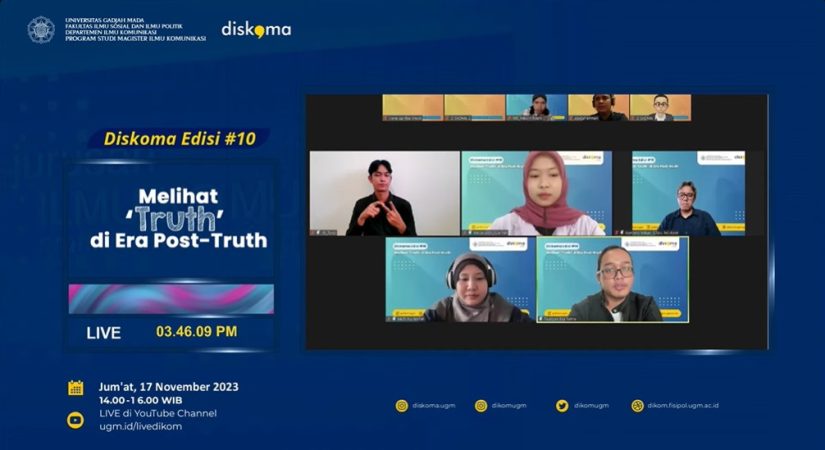
Yogyakarta, November 17th 2023─The massive development of media today is intertwined with media conglomerations where media owners have the power to create news framing and determine the direction of content distributed. As a result, the veracity of information is now at stake. As a series of events to welcome the 2023 Graduate Students Symposium on Communication Science (GSSC), the Diskusi Komunikasi Mahasiswa (Diskoma) held a webinar entitled “Seeing ‘Truth’ in the Post-Truth Era” on Friday (17/11) online via Zoom Meeting and YouTube Live – UGM Department of Communication Sciences. This discussion also supports SDGs goal point 16 regarding peace, justice, and institutions.
Faudyan Eka Satria, Master of Communication Sciences Fisipol UGM student, said that post-truth is always related to hoaxes and is exacerbated by the internet and social media. According to him, the character of post-truth is how we always try to consume information at a fast pace so that we cannot interpret the meaning of the information and this causes uncertainty.
“The definition of post-truth is no longer looking at facts as the culmination of information, but rather looking at this data as the main door before entering a healthy discussion,” he added. Faudyan said that memes are now also a representation of the younger generation enjoying information that is not just skin deep. This means that meme culture forces young people to see the deeper context that memes give to content, posts, and even phenomena.
Terminology Amono Wikan, Chair of the Information and Communications Commission of the Press Council, explained the definition of post-truth from the press and public relations perspective. According to him, truth in the context of the press is always truth related to journalism. This means that this truth is limited by journalistic works which have rules and guidelines that must be adhered to to create quality information. Amono also said that the truth has now been perceived by the public.
“This is a serious problem with mainstream media newsrooms. The agenda setting and framing that was built was destroyed because the public doesn’t need that, what the public needs is just the information or news they want,” explained Amono. According to him, what the public believes to be the truth is the truth.
Meanwhile, Mufti Nurlatifah, Lecturer at the Department of Communication Sciences, Faculty of Social and Political Sciences, UGM, agreed that currently, many media companies have lost public trust and legitimacy due to unverified information, incomplete framing, questionable credibility, and poor quality journalism. In fact, media companies, especially digital ones, currently have potential such as hypertextuality, interactivity, and multimediality which can be used by the media to create truth and gain trust.
“The function of the media in forming a framing that can bridge the media’s alignment with the public should be able to overcome this (problem), but this is precisely what is not happening,” he said.
Meanwhile, according to Mufti, things that need to be done by the media to maintain credibility and guarantee information to the public include providing good information with an objective point of view, facilitating multiple points of view through audience contributions in the media, paying attention to diversity, and optimizing the potential of the media in the production process. and dissemination of information.
